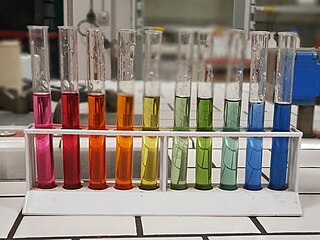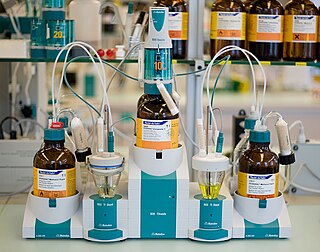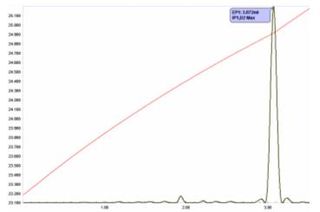Related Research Articles

Analytical chemistry studies and uses instruments and methods to separate, identify, and quantify matter. In practice, separation, identification or quantification may constitute the entire analysis or be combined with another method. Separation isolates analytes. Qualitative analysis identifies analytes, while quantitative analysis determines the numerical amount or concentration.

Infrared spectroscopy is the measurement of the interaction of infrared radiation with matter by absorption, emission, or reflection. It is used to study and identify chemical substances or functional groups in solid, liquid, or gaseous forms. It can be used to characterize new materials or identify and verify known and unknown samples. The method or technique of infrared spectroscopy is conducted with an instrument called an infrared spectrometer which produces an infrared spectrum. An IR spectrum can be visualized in a graph of infrared light absorbance on the vertical axis vs. frequency, wavenumber or wavelength on the horizontal axis. Typical units of wavenumber used in IR spectra are reciprocal centimeters, with the symbol cm−1. Units of IR wavelength are commonly given in micrometers, symbol μm, which are related to the wavenumber in a reciprocal way. A common laboratory instrument that uses this technique is a Fourier transform infrared (FTIR) spectrometer. Two-dimensional IR is also possible as discussed below.

In chemistry, pH, also referred to as acidity or basicity, historically denotes "potential of hydrogen". It is a scale used to specify the acidity or basicity of an aqueous solution. Acidic solutions are measured to have lower pH values than basic or alkaline solutions.

Titration is a common laboratory method of quantitative chemical analysis to determine the concentration of an identified analyte. A reagent, termed the titrant or titrator, is prepared as a standard solution of known concentration and volume. The titrant reacts with a solution of analyte to determine the analyte's concentration. The volume of titrant that reacted with the analyte is termed the titration volume.

In analytical chemistry, Karl Fischer titration is a classic titration method that uses coulometric or volumetric titration to determine trace amounts of water in a sample. It was invented in 1935 by the German chemist Karl Fischer. Today, the titration is done with an automated Karl Fischer titrator.

An acid–base titration is a method of quantitative analysis for determining the concentration of Brønsted-Lowry acid or base (titrate) by neutralizing it using a solution of known concentration (titrant). A pH indicator is used to monitor the progress of the acid–base reaction and a titration curve can be constructed.
In analytical electrochemistry, coulometry determines the amount of matter transformed during an electrolysis reaction by measuring the amount of electricity consumed or produced. It can be used for precision measurements of charge, and the amperes even used to have a coulometric definition. However, today coulometry is mainly used for analytical applications. It is named after Charles-Augustin de Coulomb.
The equivalence point, or stoichiometric point, of a chemical reaction is the point at which chemically equivalent quantities of reactants have been mixed. For an acid-base reaction the equivalence point is where the moles of acid and the moles of base would neutralize each other according to the chemical reaction. This does not necessarily imply a 1:1 molar ratio of acid:base, merely that the ratio is the same as in the chemical reaction. It can be found by means of an indicator, for example phenolphthalein or methyl orange.
Amperometric titration refers to a class of titrations in which the equivalence point is determined through measurement of the electric current produced by the titration reaction. It is a form of quantitative analysis.
In chemistry, the iodine value is the mass of iodine in grams that is consumed by 100 grams of a chemical substance. Iodine numbers are often used to determine the degree of unsaturation in fats, oils and waxes. In fatty acids, unsaturation occurs mainly as double bonds which are very reactive towards halogens, the iodine in this case. Thus, the higher the iodine value, the more unsaturations are present in the fat. It can be seen from the table that coconut oil is very saturated, which means it is good for making soap. On the other hand, linseed oil is highly unsaturated, which makes it a drying oil, well suited for making oil paints.
In chemistry, acid value is a number used to quantify the acidity of a given chemical substance. It is the quantity of base, expressed as milligrams of KOH required to neutralize the acidic constituents in 1 gram of a sample.
The Kjeldahl method or Kjeldahl digestion (Danish pronunciation:[ˈkʰelˌtɛˀl]) in analytical chemistry is a method for the quantitative determination of nitrogen contained in organic substances plus the nitrogen contained in the inorganic compounds ammonia and ammonium (NH3/NH4+). Without modification, other forms of inorganic nitrogen, for instance nitrate, are not included in this measurement. Using an empirical relation between Kjeldahl nitrogen content and protein content it is an important method for analyzing proteins. This method was developed by Johan Kjeldahl in 1883.

A thermometric titration is one of a number of instrumental titration techniques where endpoints can be located accurately and precisely without a subjective interpretation on the part of the analyst as to their location. Enthalpy change is arguably the most fundamental and universal property of chemical reactions, so the observation of temperature change is a natural choice in monitoring their progress. It is not a new technique, with possibly the first recognizable thermometric titration method reported early in the 20th century. In spite of its attractive features, and in spite of the considerable research that has been conducted in the field and a large body of applications that have been developed; it has been until now an under-utilized technique in the critical area of industrial process and quality control. Automated potentiometric titration systems have pre-dominated in this area since the 1970s. With the advent of cheap computers able to handle the powerful thermometric titration software, development has now reached the stage where easy to use automated thermometric titration systems can in many cases offer a superior alternative to potentiometric titrimetry.
In analytical chemistry, potentiometric titration is a technique similar to direct titration of a redox reaction. It is a useful means of characterizing an acid. No indicator is used; instead the electric potential is measured across the analyte, typically an electrolyte solution. To do this, two electrodes are used, an indicator electrode and a reference electrode. Reference electrodes generally used are hydrogen electrodes, calomel electrodes, and silver chloride electrodes. The indicator electrode forms an electrochemical half-cell with the interested ions in the test solution. The reference electrode forms the other half-cell.

Naphthenic acids (NAs) are mixtures of several cyclopentyl and cyclohexyl carboxylic acids with molecular weights of 120 to well over 700 atomic mass units. The main fractions are carboxylic acids with a carbon backbone of 9 to 20 carbons. McKee et al. claim that "naphthenic acids (NAs) are primarily cycloaliphatic carboxylic acids with 10 to 16 carbons", although acids containing up to 50 carbons have been identified in heavy petroleum. The term naphthenic acid has roots in the somewhat archaic term "naphthene" used to classify hydrocarbons. It was originally used to describe the complex mixture of petroleum-based acids when the analytical methods available in the early 1900s could identify only a few naphthene-type components with accuracy. Today "naphthenic" acid is used in a more generic sense to refer to all of the carboxylic acids present in petroleum, whether cyclic, acyclic, or aromatic compounds, and carboxylic acids containing heteroatoms such as N and S. Although commercial naphthenic acids often contain a majority of cycloaliphatic acids, multiple studies have shown they also contain straight chain and branched aliphatic acids and aromatic acids; some naphthenic acids contain >50% combined aliphatic and aromatic acids.
In analytical chemistry, the hydroxyl value is defined as the number of milligrams of potassium hydroxide (KOH) required to neutralize the acetic acid taken up on acetylation of one gram of a chemical substance that contains free hydroxyl groups. The analytical method used to determine hydroxyl value traditionally involves acetylation of the free hydroxyl groups of the substance with acetic anhydride in pyridine solvent. After completion of the reaction, water is added, and the remaining unreacted acetic anhydride is converted to acetic acid and measured by titration with potassium hydroxide.
Copper naphthenate is the copper salt of naphthenic acid. Naphthenic acid is a term commonly used in the petroleum industry to collectively refer to all of the carboxylic acids naturally occurring in crude oil. Naphthenic acids are primarily cycloaliphatic carboxylic acids with 10 to 24 or more carbons, although substantial quantities of non-cyclic, aromatic and heteroatom- containing carboxylic acids are also present. Copper naphthenate is most widely used in wood preservation and for protecting other cellulosic materials such as textiles and cordage from damage by decay fungi and insects. Other metal naphthenates are used as paint driers, rubber adhesion promoters, lubricant additives, and catalysts where oil solubility is required.
Base Number (BN) is a measurement of basicity that is expressed in terms of the number of milligrams of potassium hydroxide per gram of oil sample. BN is an important measurement in petroleum products, and the value varies depending on its application. BN generally ranges from 6–8 mg KOH/g in modern lubricants, 7–10 mg KOH/g for general internal combustion engine use and 10–15 mg KOH/g for diesel engine operations. BN is typically higher for marine grade lubricants, approximately 15-80 mg KOH/g, as the higher BN values are designed to increase the operating period under harsh operating conditions, before the lubricant requires replacement.

Olive oil contains small amounts of free fatty acids. Free acidity is an important parameter that defines the quality of olive oil. It is usually expressed as a percentage of oleic acid in the oil. As defined by the European Commission regulation No. 2568/91 and subsequent amendments, the highest quality olive oil must feature a free acidity lower than 0.8%. Virgin olive oil is characterized by acidity between 0.8% and 2%, while lampante olive oil features a free acidity higher than 2%. The increase of free acidity in olive oil is due to free fatty acids that are released from triglycerides.

Calconcarboxylic acid is an azo dye that is used as an indicator for complexometric titrations of calcium with ethylenediaminetetraacetic acid (EDTA) in the presence of magnesium. Structurally, it is similar to eriochrome blue black R, which is obtained from calconcarboxylic acid by decarboxylation and reaction with sodium hydroxide.
References
- 1 2 "Lab Services > TAN test". CPI Engineering. Retrieved 2 June 2014.
- ↑ Jingyan, L.; Xiaoli, C.; Songbai, T. (2012). "Research on Determination of Total Acid Number of Petroleum Using Mid-infrared Attenuated Total Reflection Spectroscopy". Energy & Fuels. 26 (9): 5633. doi:10.1021/ef3002372.
- ↑ "Petroleum Characteristics and Analysis". ASDI. Retrieved 2 June 2014.
- ↑ Sjöblom, J.; Aske, N.; Harald Auflem, I.; Brandal, Ø.; Erik Havre, T.; Sæther, Ø.; Westvik, A.; Eng Johnsen, E.; Kallevik, H. (2003). "Our current understanding of water-in-crude oil emulsions". Advances in Colloid and Interface Science. 100–102: 399–473. doi:10.1016/S0001-8686(02)00066-0. p. 404
- Robert O'Leary BevSense LLC. "Testing Brix and Acid In-Line for the Beverage Industry" (PDF). – O'Leary describes the theory and practice of measuring Total acid number on-line in beverages.